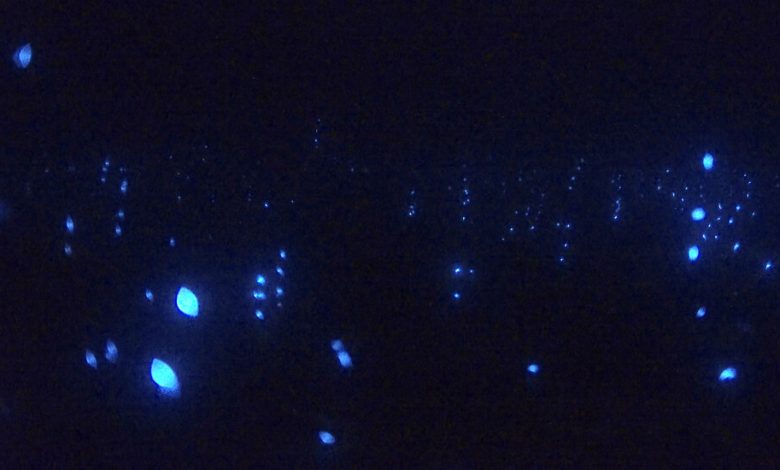These Underwater Fireworks Are From ‘Sea Fireflies’ Looking for Mates

In 2017, two evolutionary biologists snorkeling off Panama’s coast made a dazzling discovery.
Night was falling over the shallow waters of Bocas del Toro, and James Morin, an emeritus professor at Cornell University, flicked on his underwater flashlight to catch a glimpse of the seabed.
Seemingly in answer, hundreds of tiny blue lights sparked to life, rippling out in waves.
“We were both kind of swearing into our snorkels in amazement,” said Todd Oakley, a professor at the University of California, Santa Barbara.
In a paper published Wednesday in Proceedings of the Royal Society B, the scientists detailed the courtship rituals of a new species of “sea firefly” — a tiny crustacean no larger than a grain of sand that stages a spectacular underwater display by sneezing up glowing mucus.
But these aren’t simple flashes. Like the synchronous group displays of lightning bugs on land, the sea fireflies’ light show is a carefully choreographed dance in harmony with the rhythms of the night sky.
“It’s a fireworks display underwater — the best Fourth of July you’ve ever seen,” said Nicholai Hensley, a postdoctoral fellow at Cornell who studies animal behavior and led the new study.

An example of an ostracod resting on a sand bed at night in Indonesian waters.Credit…FLPA, via Alamy
The creatures behind the eerie Panamanian light show are called ostracods. Dr. Hensley compares the itty-bitty crustaceans to sesame seeds with eyeballs. Under a microscope, you can make out an ostracod’s shrimplike body encased in a see-through shell.
A bizarre organ called the “upper lip” makes many ostracods bioluminescent. The upper lip stores two chemicals that when combined, create a bright blue burst.
“It’s literally like a handlebar mustache of glowing light right above their mouth,” Dr. Hensley said.
Ostracods around the world use their luminous snot for many purposes, like performing courtship displays or forcing predators to spit them back up (apparently the mucous tastes really bad). But Dr. Morin said the light display of the sea fireflies was “on steroids” the night he and Dr. Oakley observed them, and coordinated in a way that other species’ aren’t.
The team studied this mysterious population of sea fireflies, which carry the temporary name “E.G.D.” (for “entraining grassbed downer”), and convinced it to give encores of the light show in captivity. Now, the researchers believe they’ve pieced together the individual steps of E.G.D.’s courtship dance.
The romance begins at nautical twilight — an in-between time when the sun has set, the moon has yet to rise and the sea fireflies’ only competition for luminosity is the starlight. Each male motors up from the grass beds and then descends in a tight, corkscrewing plunge, sneezing up between four and eight globs of light as it goes. The result is stunning, the scientists agreed, like a string of Christmas lights or a strand of glowing pearls.

The new research documents how and when males produce their displays simultaneously. The synchronization can spread for many meters, despite each animal being the size of a sand grain. Video is 1.5x speed.CreditCredit…Presley Adamson and Christy Chamberlain/Monterey Bay Aquarium
E.G.D. males are highly suggestible, the team found. The first male to produce glowing snot triggers a chain reaction as his neighbors follow suit, resulting in ripples of light. And the farther a sea firefly is from his nearest rival, the more snot pearls he produces — perhaps because he has a better chance at wooing females if his competitors are out of reach.
While bioluminescence is common in the ocean, this kind of coordinated, group display is impressive for a creature the size of a sesame seed, said Edith Widder, a bioluminescence expert and chief executive of the Ocean Research and Conservation Association, who wasn’t involved with the study.
Dr. Widder praised Dr. Hensley’s study for providing “rare” insight into bioluminescent courtship, which generally occurs beyond scientists’ reach. She said the phenomenon is a striking example of convergent evolution as both aquatic and terrestrial fireflies separately evolved similar displays, though the two creatures’ last common ancestor lived about 500 million years ago.
In some ways, Dr. Widder added, E.G.D.’s light show is even more ingenious than their winged cousins’— the firefly has to give away its position when its light blinks, but the sea firefly can put distance between itself and its belched-up light. It is like a glowing, encoded map — the females of the species know how to “read” the display to find their snotty suitors, while predators are left snapping at their tracks.
Dr. Hensley said he can’t help but marvel at how this incredible dance had been playing out, unobserved, yet so close to civilization. In the Bocas del Toro sea grass beds where the species was discovered, as the ostracods form their underwater constellations in the hopes of finding love, you can hear the thumping bass from the discoteca just up the beach.




